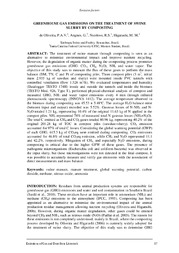Greenhouse gas emissions on the treatment of swine slurry by composting.
Greenhouse gas emissions on the treatment of swine slurry by composting.
Author(s): OLIVEIRA, P. A. V. de; ANGNES, G.; NICOLOSO, R. da S.; HIGARASHI, M. M.
Summary: The treatment of swine manure through composting is seen as an alternative to minimize environmental impact and im prove nutrient recycling. However, the degradation of organic matter during the composting process promotes greenhouse gas emissions (GHG: CO2, CH4, N2O), NH3 and water vapor. The objective of this study was to measure the flux of these gases to perform the mass balance (DM, TN, C and P) of composting piles. Three compost piles (3 m3, initial mass .935 kg of sawdust and slurry) were mounted inside PVC tunnels with controlled ventilation (flow 1.526 m3 /h). We evaluated temperatures and humidity (Datalogger TESTO 174H) inside and outside the tunnels and inside the biomass (TESTO Mod. 926, Type T), performed physical-chemical analysis of compost and measured GHG, NH3 and water vapor emissions every 4 min through infra red photoacoustic spectroscopy (INNOVA 1412). The average temperature observed in the biomass during composting was 45.53 ± 5.48ºC. The average H2O balance error (between input and output) recorded was 5.52%. Gaseo us losses of N-NH3 and N-N2O totaled 1.21 kg, representing 10.4% of the original 11.63 kg of N applied in the compost piles. NH3represented 78% of measured total N gaseous losses(NH3+N2O). The total C emitted as CH4 and CO2 gases totaled 80.96 kg, representing 40.2% of the original 201.28 kg of TOC in compost piles (sawdust+slurry). CO2 emission accounted for 97% of total C losses. Considering the global warming potential (GWP) of each GHG, 615.3 kg of CO2 eq were emitted duringcomposting. CO2 emissions accounted for 46.8% of total CO2 eq emission, while CH4 and N2O represented 11.1 and 42.2%, respectively. Mitigation of CH4, and especially N2 O emissions, during composting is critical due to the higher GPW of the se gases. The presence of pathogenic microorganisms (Escherichia coli and coli form bacteria) was observed in the input slurry, but those microorganisms were not detected in the final compost. It was possible to accurately measure and verify gas emissions with the association of direct measurements and mass balance.
Publication year: 2013
Types of publication: Paper in annals and proceedings
Unit: Embrapa Swine & Poultry
Observation
Some of Embrapa's publications are published as ePub files. To read them, use or download one of the following free software options to your computer or mobile device. Android: Google Play Books; IOS: iBooks; Windows and Linux: Calibre.
Access other publications
Access the Agricultural Research Database (BDPA) to consult Embrapa's full library collection and records.
Visit Embrapa Bookstore to purchase books and other publications sold by Embrapa.

